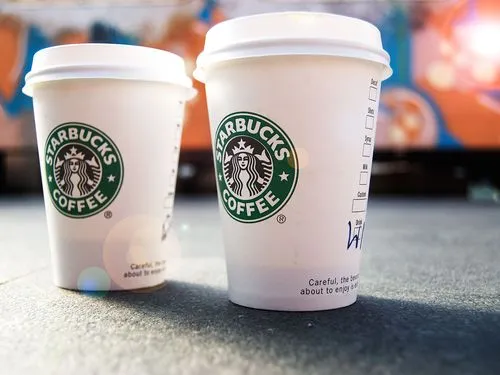The issue of plastic waste stemming from the increasing popularity of cold drinks at Starbucks has garnered significant attention in recent times.
As sales of Frappuccinos, Refreshers, cold brews, and other iced beverages soar, so does the environmental concern surrounding the single-use cups in which these drinks are served.
In response to this pressing problem, the coffee giant has announced its plans to address the issue by introducing new disposable cups that contain up to 20% less plastic.
These innovative cups are scheduled to be introduced in Starbucks stores across the United States and Canada starting this month.
Amelia Landers, the Vice President of Product Innovation at Starbucks, revealed that the company dedicated four years to developing these new containers.
Through rigorous testing and experimentation, engineers explored numerous iterations to determine the optimal amount of plastic reduction without compromising the cup’s durability.
Landers expressed confidence in the new cups, describing them as “industry-leading” and the epitome of excellence in cold plastic cup design.
The surge in demand for Frappuccinos and other cold beverages has significantly impacted Starbucks’ beverage sales, with cold drinks now constituting 75% of its U.S. sales, a substantial increase from 37% in 2013.
The company anticipates that the implementation of the new cups will prevent over 13.5 million pounds of plastic from entering landfills annually.
Furthermore, the production of these cups is more environmentally friendly, requiring less water and generating fewer carbon emissions, thus contributing to the mitigation of climate change, a crucial global issue.
In addition to reducing plastic waste, Starbucks has introduced several other modifications as part of the cup redesign. The new cold cups feature raised dots near the base, enabling baristas, including those with visual impairments, to quickly identify the cup size by touch.
Moreover, the 12-ounce cup, known as the “tall” size in Starbucks parlance, has been redesigned to be shorter and wider, allowing it to accommodate the same-sized lid as larger cups.
The initiatives undertaken by Starbucks underscore the company’s commitment to sustainability and environmental responsibility.

By innovating new cup designs, reducing plastic usage, and implementing inclusive features for employees, Starbucks sets a commendable example for the food and beverage industry.
As consumers become increasingly conscious of environmental issues, such initiatives not only benefit the planet but also enhance the brand’s reputation and appeal to environmentally conscious customers.
In conclusion, Starbucks’ endeavor to address the plastic waste predicament associated with its cold drink sales exemplifies proactive corporate responsibility and sustainability efforts.
By introducing eco-friendly cups, the company not only reduces its environmental footprint but also sets a precedent for other businesses to prioritize sustainability in their operations.
As the global community grapples with the challenges of climate change and environmental degradation, initiatives like these serve as crucial steps towards a more sustainable and eco-conscious future.
In recent years, there has been a notable shift towards sustainability in the corporate world, with many companies recognizing the importance of reducing their environmental footprint.
One such company leading the charge is Starbucks, as evidenced by their latest initiative involving the introduction of new reusable cups.
This move is part of a broader sustainability push within the company, following previous efforts such as the adoption of strawless lids in 2019 and the acceptance of customer-provided cups for certain orders in the U.S. and Canada.
Looking ahead, Starbucks has ambitious plans to implement a reusable cup program across thousands of stores in Europe, the Middle East, and Africa by the upcoming year.
This program involves customers paying a small deposit when purchasing a drink in a specially designed cup that can be reused up to 30 times. Upon returning the cup to a store, customers will receive their deposit back, incentivizing the use of reusable containers.
While Starbucks has been testing similar programs in select U.S. markets, the company acknowledges the varying challenges and customer behaviors across different regions.
As stated by a Starbucks representative, “Every market has their own challenges, their own requirements and customer behavior. Some are more prime for reusables, some are less prime for reusables.” This recognition underscores the need for tailored approaches to sustainability initiatives based on local contexts.
In the long term, Starbucks has set an ambitious target for all its packaging to be reusable, recyclable, or compostable by 2030. The recent introduction of a reduced-plastic cup marks a small but significant step towards achieving this goal.
Despite the cup being recyclable, it was initially designed for single-use purposes, highlighting the ongoing need for innovation in sustainable packaging solutions.
Looking ahead, Starbucks remains committed to exploring new technologies and methods to further enhance the sustainability of its operations.
According to company spokesperson Landers, “I think we will never take our foot off the gas, evaluating new ways and new methods and new technologies to go further. We’re not done.” This dedication to continuous improvement underscores Starbucks’ proactive approach towards environmental stewardship.
It is important to note that Starbucks is not alone in its efforts to reduce plastic packaging. Other major corporations, such as McDonald’s and Coca-Cola, have also taken steps towards sustainability.
McDonald’s has introduced eco-friendly alternatives like McFlurry cups without plastic lids and renewable fiber-based salad boxes and cutlery.

Similarly, Coca-Cola has developed a plant-based bottle, demonstrating the feasibility of scaling up sustainable technologies in the commercial sector.
In conclusion, Starbucks’ commitment to sustainability through initiatives like the reusable cup program reflects a broader trend towards environmental consciousness in the corporate world.
By setting ambitious goals, testing innovative solutions, and collaborating with industry peers, Starbucks is paving the way for a more sustainable future.
As consumers increasingly prioritize eco-friendly practices, companies must continue to adapt and evolve their approaches to packaging and waste management. The journey towards a more sustainable world requires collective effort and ongoing dedication from all stakeholders involved.
